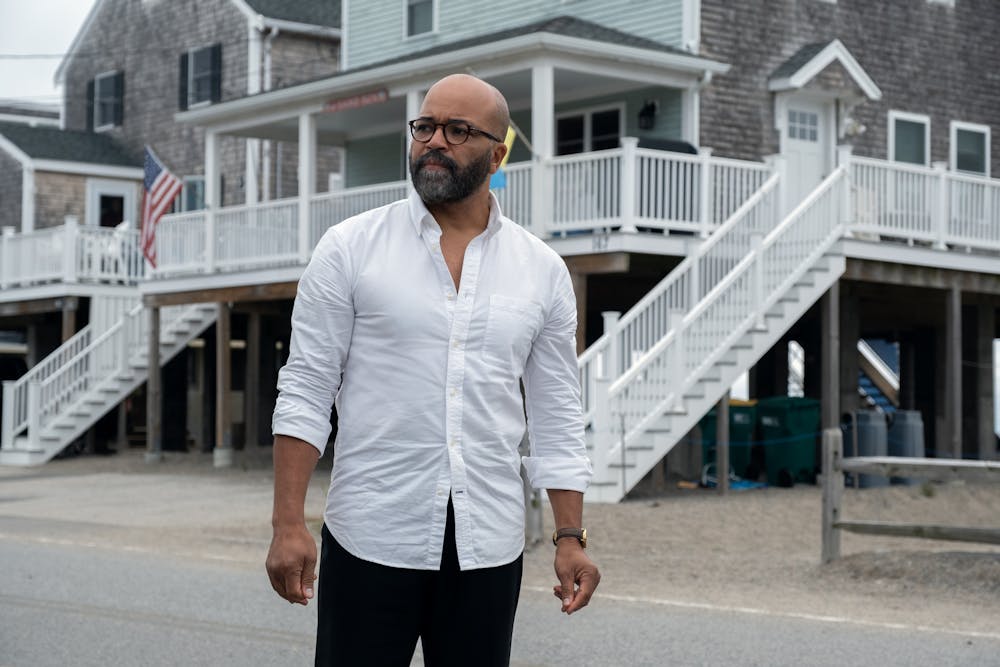A death, a wedding and a very complicated family dynamic. You may be picturing a Greek tragedy, but these are all aspects found in Oscar contender, “American Fiction.”
Emmy-award winning writer Cord Jefferson makes his directorial debut in an adaptation of the novel “Erasure" by Percival Everett. He offers his insight on the perception of Black stories in the media. It raises the questions, “what Black stories do white-dominated industries choose to ‘uplift’ and share?” and “what does it actually mean to be Black?”
The story centers around Thelonious "Monk" Ellison, a Harvard-educated writer and academic. He struggles to get his Greek-tragedy-inspired novels published and perceived in the way he sees fit. He doesn’t want to see his books in the Black section of the bookstore; he wants his work to be separate from his identity rather than have the two forced together. “These books have nothing to do with African American studies,” Monk said to the bookstore employee. “They’re just literature.”
Much to his horror, he watches as a fellow renowned Black author gains commercial and critical success for her book “We’s Lives in Da Ghetto.” This author, Sinatra Golden, uses Black stereotypes to sell her work and the audience eats it up. Appalled, and even a bit jealous, by her success, Monk decides to retaliate by writing a parody of her novel.
Not only does he invent the story in his book but he invents a backstory for his pen name. Thelonious Ellison, writer and academic, becomes replaced by "Stagg R. Leigh,” a convict on the run from the law. Before long, Monk becomes entangled in his lies, as well as his frustrations with the world, and he is unable to escape the situation he’s put himself in. He may not be an ex-convict, yet he finds himself on the run.
The satirical elements make this film a treasure. The over-apologeticness and extreme savior complex that the white characters portray may seem like a dramatization, but they perfectly encapsulate the ignorance that these so-called “allies” possess. From the book publishers, to the director who wants to adapt the book into a film, they all believe that they are doing their part in uplifting black stories. Yet they fail to realize that they are confining an entire group of people, 47.9 million Americans, into archetypes that ignore the complexity of the Black identity.
By choosing to center the story on Monk and his upper-middle class family, Jefferson brings attention to the Black upper and middle class, which has existed in America since the Antebellum era. The white characters in the film seem to believe that they are being racially conscious by solely focusing on the narrative that all Black people come from poverty, that they have all experienced life in the “ghetto.” Even their idea of what the “ghetto” is and what it’s like to live there is unrealistic, full of over-the-top violence and situations that are not the experience of most Black Americans.
Monk’s family is completely dysfunctional, but I thought it added a beautiful layer to his depth as a character and gave the audience some of the most charming moments in the film.
His younger brother, a 40-year old man, has just begun to embrace his identity as a gay man and engages in rather self-destructive behavior as he goes through a messy divorce with his ex-wife. His lack of maturity gets on Monk’s nerves, leading to some of the most hilarious moments, like them slapping each other in the pool, that perfectly capture the love-hate relationship one has with a younger sibling. Meanwhile, Monk’s cool older sister charms the audience right away, with wisdom and humor that every eldest sister seems to possess. Although her time was cut short by her sudden death, it was clear how much she really meant to Monk and how her absence launched their family into a whirlwind of misfortune.
Jefferson made it his goal to challenge the narratives that always seem to follow Black characters on screen. The details and backstory that went into creating the characters’ personalities were carefully thought out, making them not only endearing, but also presented them with issues that any person could find themselves facing.
“American Fiction” demonstrates the importance of giving Black creatives the opportunity to tell their own stories. Only then will we begin to dismantle the harmful narratives that are associated with the Black community. We don’t uplift Black voices by utilizing trauma as a form of entertainment. We uplift Black voices by allowing them to be free from expectations of what a Black story is. How else will we admire the diversity and beauty of Black America?
Tiffany Marquez Escobar is a reporter at The Beacon. She can be reached at marqueze25@up.edu.








